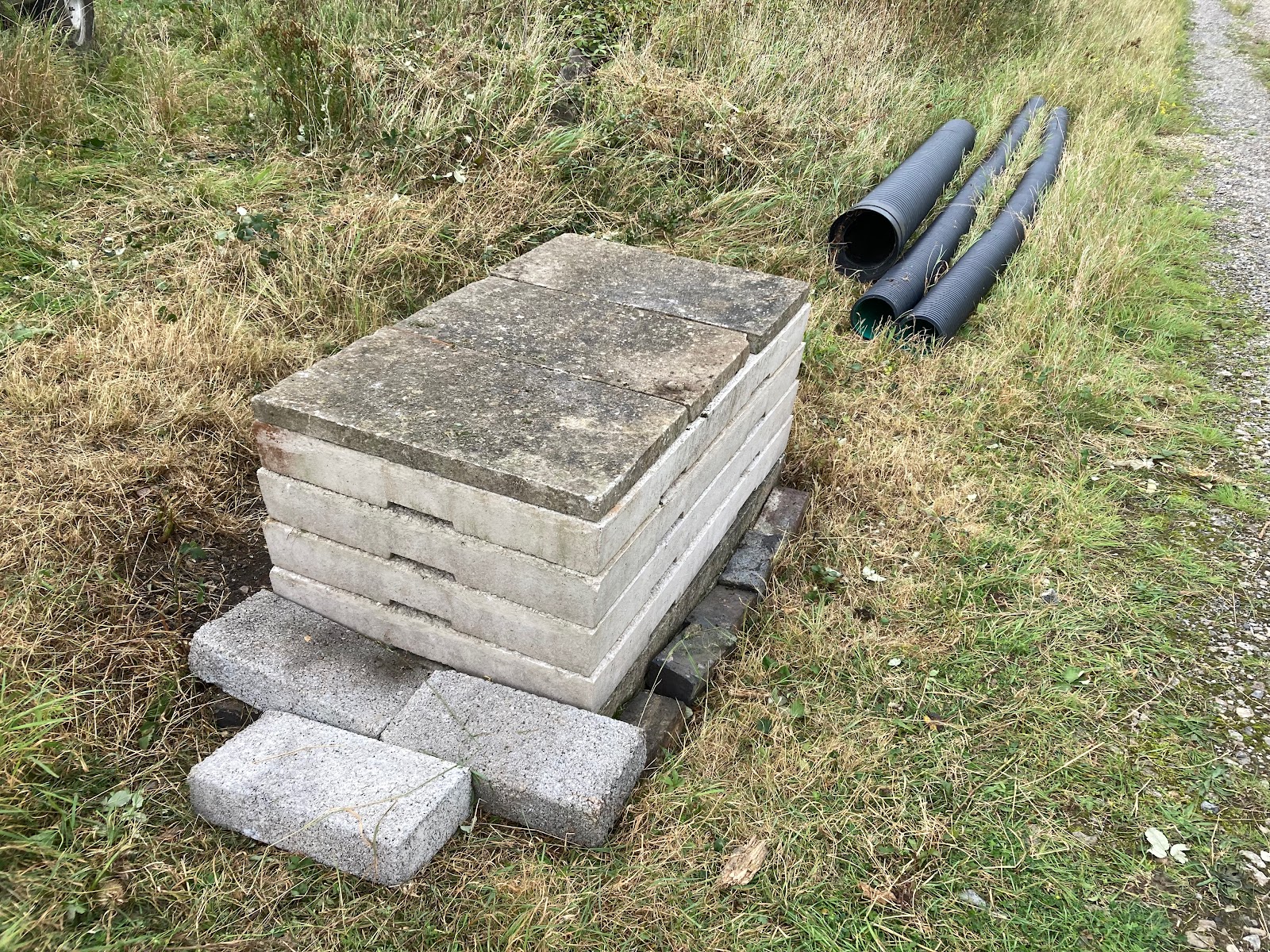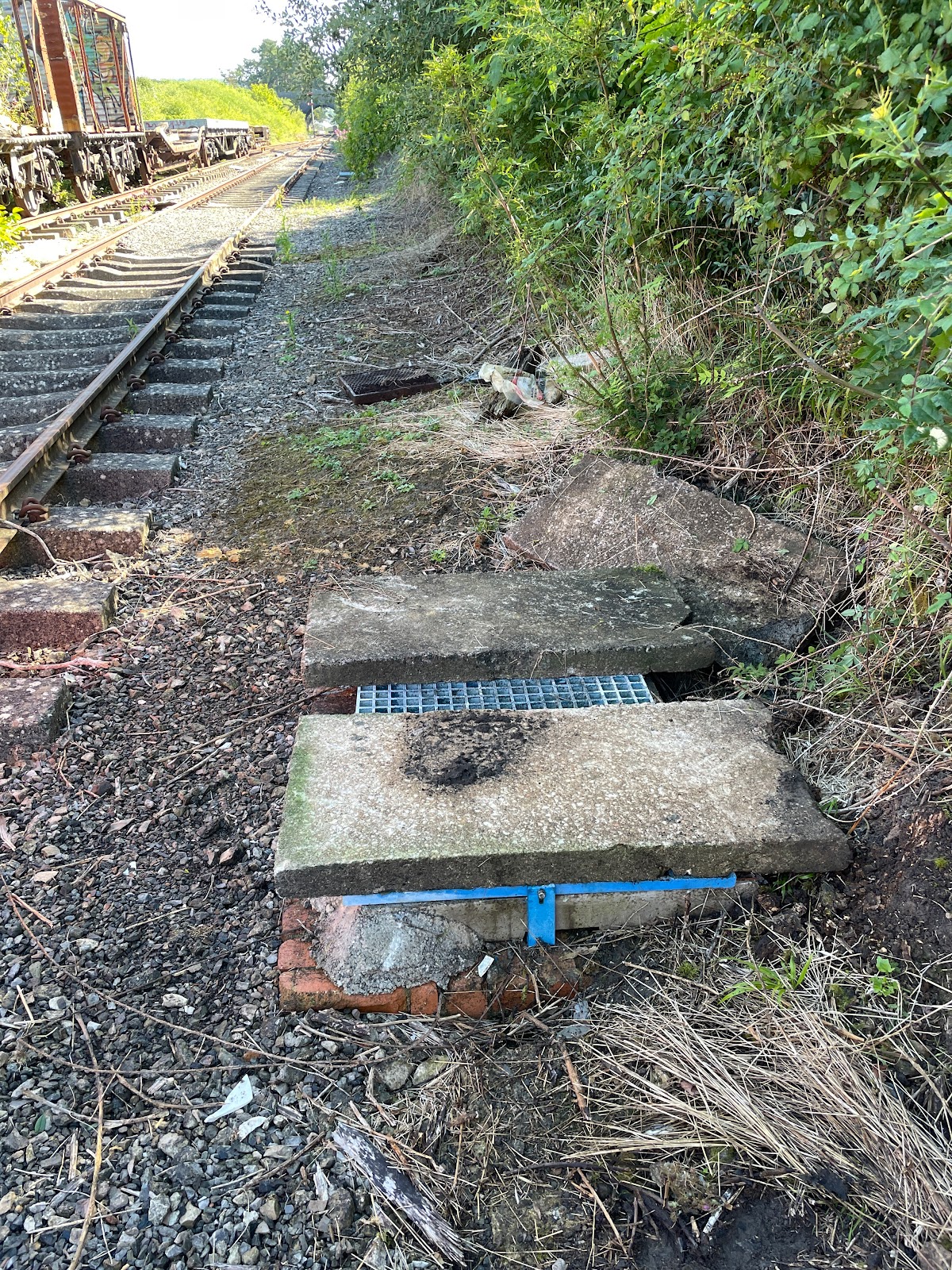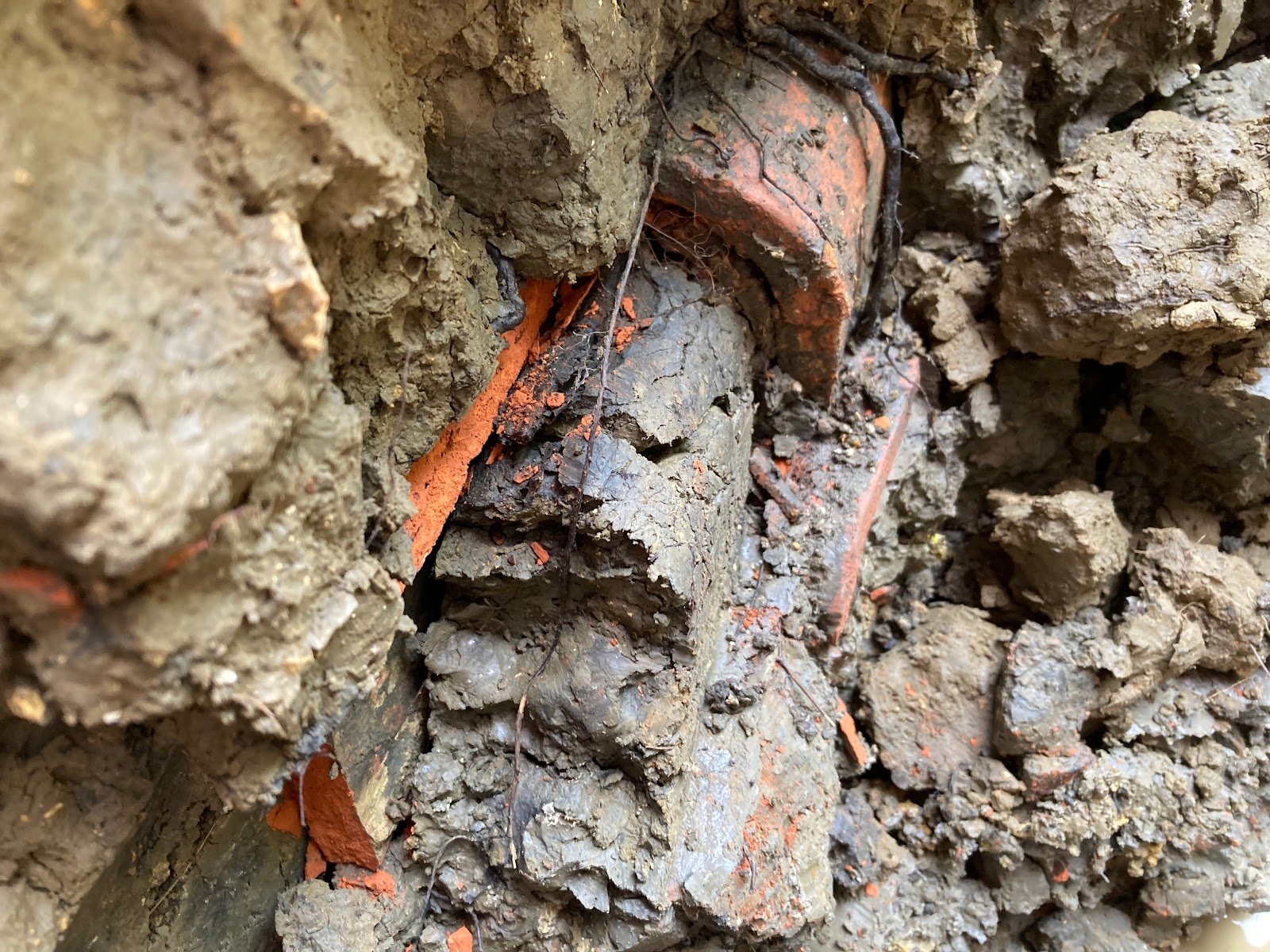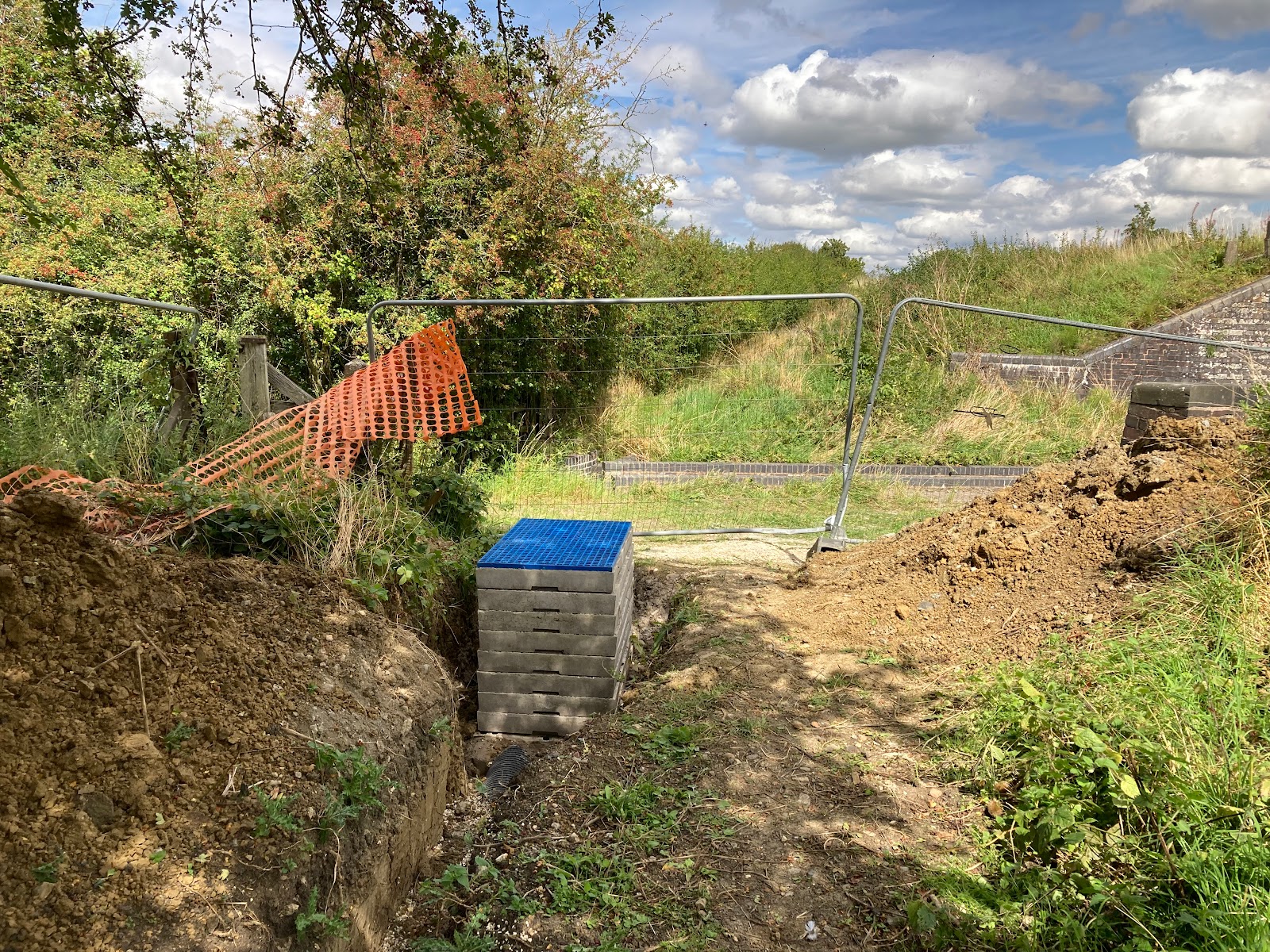During the summer at Stanton we have constructed five new chambers using traditional concrete catch pit rings. These are heavy, each requires at least three and preferably four people to lift when placing onto the chamber stack. The 11B to 11A up side diversion used three dozen, so a lot of work shifting and placing them. Admittedly, for two of the chambers we were able to use the telehandler to assist with the placement. At the Rail Live show in early summer, we spotted catchment rings made from GRP, so much lighter. So light that one person can comfortably lift a standard size ring. Increasing the height of a deep manhole near the Usk Hut in the up side yard at Winchcombe was the ideal opportunity to try these out. This was a great success; the lightness of the rings made for both a quicker and a safer installation. The only drawback is that each ring costs over twice that of comparable concrete ones.
Thursday 7th September
Six hardy folk attending on what will almost certainly turn out to be our hottest working day this year.
Nigel, Dave and Martin were extra hot heroes as they use the two working heavy duty brushcutters to clear the vegetation around Bridge 17A and Culvert 17B. These are the two big culverts south of Hayles Abbey Halt. This was the first clearance following the end of the bird nesting season. These two culverts we done first to that they were ready for visual inspections by the bridge team.
 |
| Inside culvert 17B - bone dry after a week of hot dry weather. [Photo by Martin] |
Jonathan, Polly and Andrew shifted 1.5 tonnes of mixed stone and rubble to back fill around the exit chamber on the up side 11B to 11A diversion at Stanton. Then collected 1.5 tonnes of pea gravel from Elliots which was barrowed into the trench between the second and third intermediate chambers. This completed the packing of the pipe with pea gravel. Parts of culvert 11A were cleared of weed as the water level was well down.
 |
| Finally all the pipe on the 11B to 11A diversion is covered with pea gravel. Just needs the trench infilled and all our good work disappears from sight! |
Special thanks to Elliot’s for donating two more long handle American style shovels - these really make shifting loose material so much easier. (Not new technology as such – but technology from the New World. You have to admit that the Americans do have some good ideas!)
Thursday 14th September
A much reduced group of only 4 in today. Hence only a limited amount of jobs completed, and not helped by the wet weather.
First task was to move the latest delivery of cement into the store shed – even in plastic bags cement can get damp and then become a solid lump.
The main task was the clearance of culverts 24A and 24B at Working Lane, Gretton. However, first thing was to clear the haul road gateway at Working Lane, and then a turning point for vehicles at the top of the haul road opposite the Royal Oak pub.
 |
| Down side crest chamber of culvert 24A after clearing. Garden of Royal Oak in the background. [Photo by Roger] |
All the cess chambers between Greet Tunnel and Royal Oak were cleared, plus both sides of 24A and the up side of 24B. Rain and exhaustion then stopped further work!
Thursday 21st September
Only three intrepid members of the team in attendance, all of them had been absent last week.
First was a visit to Royal Oak (Working Lane) to undertake he internal visual survey of culvert 24A. This has an extension to the bore on the up (exit) side which uses a deteriorating steel plate as the roof. The are more laminations visible in this than at last year's inspection. Hence it does need rebuilding - which has to be a contractor job and when no trains are running as this is under the vacant up track bed so close to the running line. We will need to schedule this rebuild for one of the winter shutdown periods in the next couple of years.
 |
| The up side extension of culvert 24A with the rusting steel roof. We are not sure when this was built, possibly at the same time as BR(W) work at Winchcombe in the 1950s. |
Then up to Stanton to check how the water is flowing in the new 11B to 11A upside exit diversion. Surprisingly only a trickle exiting into 11A even after a couple of wet days. The sumps in the intermediate chambers are filling up.
Finally the main task of the day; installing the recently arrived GRP rings (Cubis STAKKAbox) on the deep manhole near the Usk building in Winchcombe up yard. The ring installation took less than half an hour - each ring is light enough to be lifted safely by one person. We secured the lowest ring in position with mortar. The subsequent ones stack snugly, just like big Lego blocks. The rest of the morning and early afternoon were spent backfilling around the new rings using the mix of soil and rubble from by the boundary fence of the yard. All done under the watchful eyes of the Heritage Usk team, they were as pleased as us at the huge visual improvement, including removal of most the heras fence panels. We fitted blue mesh covers temporarily as the proper lockable lids from Cubis will be delivered next week.
 |
| The four GRP catch pit rings have raised the height of the 'Usk manhole' by 600mm. |
Careful positioning by Jonathan of the telehandler gets the back fill spoil around the chamber.
Backfill complete, temporary blue mesh cover. But what a visual transformation!
The common lizards of Winchcombe appear easier to photograph than their cousins at Stanton.
More pictures of the work by the Usk Hut are in the Lamp tops for Broadway post on the Heritage Herald blog.
Thursday 28th September
A very productive day, the seven team members attending completed all the planned items and then found time for a couple of extra tasks at Winchcombe.
All the planned work was a Stanton - but for a change this did not involve the 11B to 11A up side diversion.
 |
| Foremarke Hall heads the first up passenger train of the day at Gallery Farm crossing. |
Internal visual inspections and culvert clearance was carried out on culverts 11C and 11A and cross drain 11B. Down side slip markers at 11C were checked - no obvious sign of recent movement.
 |
| Down side inlet of culvert 11C is this plastic extension added sometime ago during embankment improvement. It needs a proper headwall - but that is not our most urgent job. |
Between bridges 10 and 11 vegetation clearance around the up side cess chambers and down side cutting crest chambers took place.
Most of the up side cess chambers between bridges 10 and 11 were raised using the spare concrete catch pit rings left over from the 11B diversion. (Yet more moving and positioning of concrete rings!). The chamber adjacent to the bridge 11 vehicle parking and turning point received 4 rings - this is now very visible when turning a vehicle.
 |
| Raised up side cess chamber near bridge 11. |
Most of the surplus pipes and other materials from the 11B up side diversion were recovered back to Winchcombe yard.
The extra tasks at Winchcombe were (1) tightening the fixings on the handrails on the down side wing walls of the River Isbourne bridge and (2) installing the lockable 3 section lid on the deep manhole by the Usk hut in the down side yard. This lid had been delivered by Cubis earlier in the day. That completes our work on that manhole, final addition of top soil and grass seeding is over to the Heritage build team.
 |
| The lockable lids neatly complete the 'Usk hut' manhole. |




















